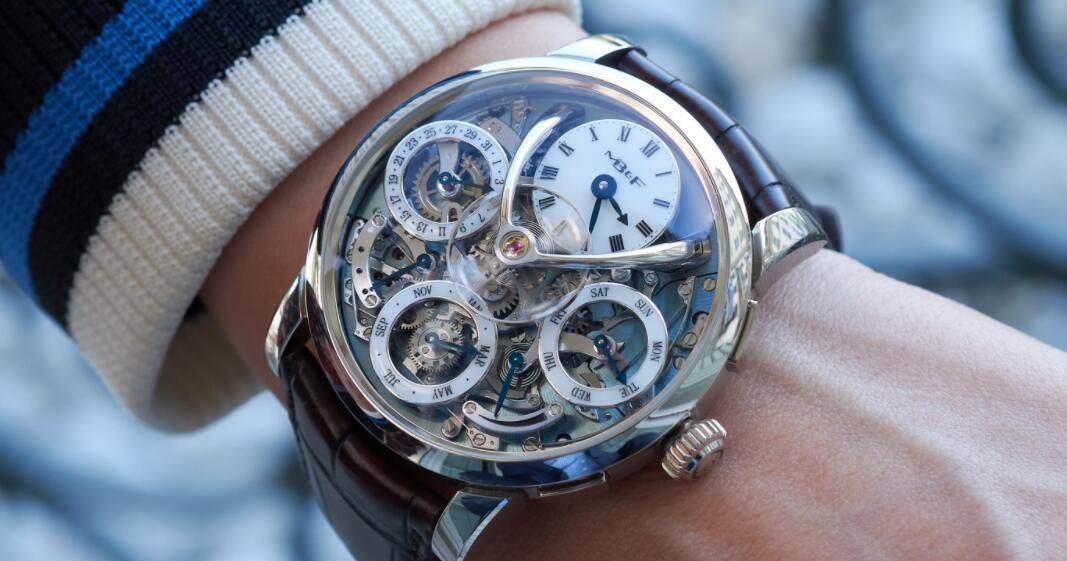At the second Geneva Watch Days MB&F filled its ‘Beau Rivage suite’ exhibition space with very exciting clocks like the ‘KB2’ clock (created by Philippe Lebru and Alain Silberstein) and the ORB MB&F x L’Epée 1839; and some no less exciting novelties for the autumn. First off here is the latest Legacy Machine Perpetual, this time in palladium.
Since its establishment in 2005 MB&F has started many interesting projects – the Horological Machines, co-creations with the clock maker L’Epée and the music automaton manufacture Reuge, limited edition ‘art meets fine watchmaking’ pieces, the M.A.D.Galleries (a special gallery dedicated to kinetic art with carefully-curated pieces from around the world in Geneva, Dubai, Hong Kong and Taipei) and the Legacy Machine collection which celebrates its 10th anniversary this year.
In 2011 the brand launched its round-cased Legacy Machine line. These more ‘classical pieces’ – classical only in MB&F’s terms – pay tribute to 19th century watchmaking excellence by reinterpreting complications from the great watchmakers of that time. As Max Büsser said – ‘what would have MB&F wanted to create 150 years ago?’
The milestone line now includes 8 calibres and features iconic haute horlogerie complications á la MB&F – like the perpetual calendar, the triple-axis Tourbillon or the double regulators.
MB&F Legacy Machine Perpetual – in palladium
One of the important pillars of MB&F’s philosophy is to work with artists and watchmakers who they admire. On the Legacy Machine Perpetual, MB&F teamed up with Stephen McDonnell (the independent Irish watchmaker and former head instructor at the WOSTEP watchmaking school). They have reinvented one of the most complex traditional horology complications: the perpetual calendar.
The first LM Perpetual was presented in 2015 and since then it exists in different versions, like in yellow gold or titanium – mostly in limited editions. The watch won the Best Calendar Watch Prize at the 2016 Grand Prix d’Horlogerie de Genève (GPHG).
The LM Perpetual EVO – launched in 2020 – is crafted from the very light and durable zirconium. On this new design there is a screw-down crown – a first for MB&F – safeguarding the 80m water-resistance of the case.
The LM Perpetual timepieces have 581-component in-house movements, created from the ground up. The integrated perpetual calendar developed for MB&F by Stephen McDonnell, featuring a dial-side complication (for example the 14mm flying balance wheel is on the centre) and a mechanical processor system architecture with inbuilt safety mechanism. Later allows the wearer to adjust the time and date easily, without the risk of damaging the movement.
On the dial you can see the hours, minutes, date, day of the week, month, leap year cycle (with a blue hand indicator around 7 o’clock) and power reserve (at 4 o’clock).
MB&F opted for a slightly less known precious metal this time: palladium. It is a shiny, silvery-white metal which belongs to the platinum group (which includes six metals: ruthenium, rhodium, palladium, osmium, iridium and platinum). Palladium is mostly used in automobile catalytic converters, but alsoin jewellery, dentistry, blood sugar test strips, aircraft spark plugs and surgical instruments – it is very malleable and is a tarnish- and corrosion-resistant metal. Currently it is more valuable than gold, since it is very rare and the demand for palladium exceeds the supply.
The novelty inherits two new features: the more ergonomic corrector pushers first seen on the above mentioned LM Perpetual EVO, and a darker movement finish on the back, offering more contrast. This latest metal version of MB&F LM Perpetual is limited to 25 timepieces, see more here.
